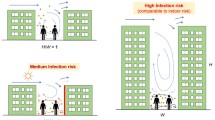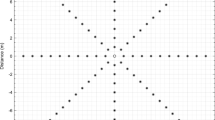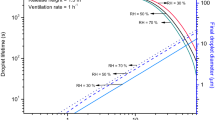Abstract
There is growing evidence of the high transmission potential of COVID-19 through virus-laden aerosols. Because aerosols are inhaled in various concentrations, an overall assessment of transmission risks at different indoor scales is crucial. However, a comprehensive risk assessment method that evaluates the direct link between short-range and room-scale zones is still lacking. In this paper, a risk assessment model combining both short-range and room-scale effects is developed to obtain effective reproduction number in confined indoor environments, called Turbulent Jet Wells Riley (TJWR) model. Combined with the viral load data and aerosol generation data of different human respiratory activities, the Monte Carlo simulation method is applied to calculate the quanta emission rate, which further provides the input parameters of the TJWR model. Three known outbreaks (Hangzhou banquet hall X, Guangzhou restaurant Y, and Hong Kong restaurant Z, China) are chosen to validate the TJWR model. Results show that the TJWR model is more efficient than the original Wells-Riley model. The average relative error of the TJWR model ranges between 9% and 44%, while for the Wells-Riley model, it ranges between 57% and 78%. The TJWR model also proves that infection risk assessments using the well-mixed assumption can systematically underestimate the transmission risk for those close to the source. Additionally, there is a significant positive linear correlation between the total number of exposed individuals at the short-range and the effective reproduction number. This newly developed TJWR model has great potential for rapid and real-time overall airborne transmission risk assessment in buildings and cities.
Similar content being viewed by others
Data availability
The data that support the findings of this study are available within the article.
Abbreviations
- ACH:
-
air change rate per hour (h−1)
- BRi :
-
exhalation rate of an index case (m3 h−1)
- BRs :
-
inhalation rate of susceptible individuals (m3 h−1)
- C :
-
quanta concentrations inhaled by susceptible individuals (quanta m−3)
- C o :
-
quanta concentration released by the index case (quanta m−3)
- Cr:
-
background quanta concentration (quanta m−3)
- c v :
-
viral load (copies mL−1)
- c i :
-
conversion factor (quanta copies−1)
- ERq :
-
quanta emission rate (quanta h−1)
- f :
-
transmission enhancement coefficient
- IR:
-
individual’s infection risk (%)
- k :
-
deposition rate (h−1)
- N :
-
number of susceptible individuals
- P :
-
individual’s infection probability (%)
- \({P_{{\rm{E}}{{\rm{R}}_{\rm{q}}}}}\) :
-
probability of occurrence of each ERq
- R :
-
effective reproduction number
- R o :
-
basic reproduction number
- R act :
-
event reproduction number
- RE:
-
relative error (%)
- \(\overline S \) :
-
average dilution ratio
- TILc :
-
combined total inward leakage rate (%)
- TOLc :
-
combined total outward leakage rate (%)
- V :
-
volume of a shared indoors (m3)
- V jd :
-
droplet volume concentration (mL m−3)
- ω :
-
short-range scale (≤2 m)
- ω 1 :
-
short-range scale (0–1 m)
- ω 2 :
-
short-range scale (1–2 m)
- ψ :
-
room-scale (>2 m)
- γ :
-
fraction of infectious aerosols (%)
- λ :
-
virus inactivation rate (h−1)
References
Agrawal A, Bhardwaj R (2021). Probability of COVID-19 infection by cough of a normal person and a super-spreader. Physics of Fluids, 33: 031704.
Allen JG, Marr LC (2020). Recognizing and controlling airborne transmission of SARS-CoV-2 in indoor environments. Indoor Air, 30: 557–558.
Bagheri G, Thiede B, Hejazi B, et al. (2021). An upper bound on one-to-one exposure to infectious human respiratory particles. Proceedings of the National Academy of Sciences of the United States of America, 118: e2110117118.
Beggs CB, Noakes CJ, Sleigh PA, et al. (2006). Methodology for determining the susceptibility of airborne microorganisms to irradiation by an upper-room UVGI system. Journal of Aerosol Science, 37: 885–902.
Beggs CB, Avital EJ (2020). Upper-room ultraviolet air disinfection might help to reduce COVID-19 transmission in buildings: a feasibility study. PeerJ, 8: e10196.
Buonanno G, Stabile L, Morawska L (2020a). Estimation of airborne viral emission: quanta emission rate of SARS-CoV-2 for infection risk assessment. Environment International, 141: 105794.
Buonanno G, Morawska L, Stabile L (2020b). Quantitative assessment of the risk of airborne transmission of SARS-CoV-2 infection: prospective and retrospective applications. Environment International, 145: 106112.
Burki TK (2022). Omicron variant and booster COVID-19 vaccines. The Lancet Respiratory Medicine, 10: e17.
Campbell F, Archer B, Laurenson-Schafer H, et al. (2021). Increased transmissibility and global spread of SARS-CoV-2 variants of concern as at June 2021. Eurosurveillance, 26: 2100509.
Cao G, Awbi H, Yao R, et al. (2014). A review of the performance of different ventilation and airflow distribution systems in buildings. Building and Environment, 73: 171–186.
Chatoutsidou SE, Lazaridis M (2019). Assessment of the impact of particulate dry deposition on soiling of indoor cultural heritage objects found in churches and museums/libraries. Journal of Cultural Heritage, 39: 221–228.
Chen W, Qian H, Zhang N, et al. (2022). Extended short-range airborne transmission of respiratory infections. Journal of Hazardous Materials, 422: 126837.
Chen W, Liu L, Zhang N, et al. (2023). Conversational head movement decreases close-contact exposure to expired respiratory droplets. Journal of Hazardous Materials, 444: 130406.
Cheng P, Luo K, Xiao S, et al. (2022a). Predominant airborne transmission and insignificant fomite transmission of SARS-CoV-2 in a two-bus COVID-19 outbreak originating from the same pre-symptomatic index case. Journal of Hazardous Materials, 425: 128051.
Cheng VCC, Lung DC, Wong SC, et al. (2022b). Outbreak investigation of airborne transmission of Omicron (B.1.1.529)–SARS-CoV-2 variant of concern in a restaurant: Implication for enhancement of indoor air dilution. Journal of Hazardous Materials, 430: 128504.
Chu DK, Akl EA, Duda S, et al. (2020). Physical distancing, face masks, and eye protection to prevent person-to-person transmission of SARS-CoV-2 and COVID-19: a systematic review and meta-analysis. The Lancet, 395: 1973–1987.
D’Orazio M, Bernardini G, Quagliarini E (2021). A probabilistic model to evaluate the effectiveness of main solutions to COVID-19 spreading in university buildings according to proximity and time-based consolidated criteria. Building Simulation, 14: 1795–1809.
Dai H, Zhao B (2022). Association between the infection probability of COVID-19 and ventilation rates: An update for SARS-CoV-2 variants. Building Simulation, 16: 3–12.
Desai PS, Sawant N, Keene A (2021). On COVID-19-safety ranking of seats in intercontinental commercial aircrafts: A preliminary multiphysics computational perspective. Building Simulation, 14: 1585–1596.
Docherty AB, Harrison EM, Green CA, et al. (2020). Features of 20 133 UK patients in hospital with covid-19 using the ISARIC WHO Clinical Characterisation Protocol: prospective observational cohort study. BMJ, 369: m1985.
Grint DJ, Wing K, Houlihan C, et al. (2022). Severity of severe acute respiratory system coronavirus 2 (SARS-CoV-2) alpha variant (B.1.1.7) in England. Clinical Infectious Diseases, 75: e1120–e1127.
Hang J, Li Y, Jin R (2014). The influence of human walking on the flow and airborne transmission in a six-bed isolation room: Tracer gas simulation. Building and Environment, 77: 119–134.
Hansen PR (2022). Relative contagiousness of emerging virus variants: An analysis of the Alpha, Delta, and Omicron SARS-CoV-2 variants. The Econometrics Journal, 25: 739–761.
Harmon M, Lau J (2022). The Facility Infection Risk Estimator™: A web application tool for comparing indoor risk mitigation strategies by estimating airborne transmission risk. Indoor and Built Environment, 31: 1339–1362.
Hasan MS, Islam MT, Alam et al. (2021). Initial reports of the SARS-CoV-2 Delta variant (B.1.617.2 lineage) in Bangladeshi patients: Risks of cross-border transmission from India. Health Science Reports, 4: e366.
Hodgson SH, Mansatta K, Mallett G, et al. (2021). What defines an efficacious COVID-19 vaccine? A review of the challenges assessing the clinical efficacy of vaccines against SARS-CoV-2. The Lancet Infectious Diseases, 21: e26–e35.
Hong Kong (2021). Installation of air purifier in catering premises. Final Report of the Working Group on Implementing the Requirement on Air Change or Air Purifier in Dine-in Restaurants. The Government of Hong Kong Special Administrative Region. Available at https://www.fehd.gov.hk. Accessed on 8th January 2022.
Hu S, Zhang Y, Yang Z, et al. (2022). Challenges and opportunities for carbon neutrality in China’s building sector—Modelling and data. Building Simulation, 15: 1899–1921.
Jia W, Wei J, Cheng P, et al. (2022). Exposure and respiratory infection risk via the short-range airborne route. Building and Environment, 219: 109166.
Jimenez JL, Peng Z, Pagonis D (2022). Systematic way to understand and classify the shared-room airborne transmission risk of indoor spaces. Indoor Air, 32: e13025.
Kampe EOI, Lehfeld AS, Buda S, et al. (2020). Surveillance of COVID-19 school outbreaks, Germany, March to August 2020. Eurosurveillance, 25: 2001645.
Ke R, Martinez PP, Smith RL, et al. (2022). Daily longitudinal sampling of SARS-CoV-2 infection reveals substantial heterogeneity in infectiousness. Nature Microbiology, 7: 640–652.
Lee JHW, Chu VH. (2003). Turbulent Jets and Plumes: A Lagrangian Approach. Boston, MA, USA: Kluwer Academic Publishers.
Li Y, Qian H, Hang J, et al. (2021a). Probable airborne transmission of SARS-CoV-2 in a poorly ventilated restaurant. Building and Environment, 196: 107788.
Li Y, Nazaroff WW, Bahnfleth W, et al. (2021b). The COVID-19 pandemic is a global indoor air crisis that should lead to change: A message commemorating 30 years of Indoor Air. Indoor Air, 31: 1683–1686.
Li Y, Cheng P, Jia W (2022a). Poor ventilation worsens short-range airborne transmission of respiratory infection. Indoor Air, 32: e12946.
Li X, Ai Z, Ye J, et al. (2022b). Airborne transmission during short-term events: Direct route over indirect route. Building Simulation, 15: 2097–2110.
Liu L, Wei J, Li Y, et al. (2017a). Evaporation and dispersion of respiratory droplets from coughing. Indoor Air, 27: 179–190.
Liu L, Li Y, Nielsen PV, et al. (2017b). Short-range airborne transmission of expiratory droplets between two people. Indoor Air, 27: 452–462.
Liu F, Zhang C, Qian H, et al. (2019). Direct or indirect exposure of exhaled contaminants in stratified environments using an integral model of an expiratory jet. Indoor Air, 29: 591–603.
Liu H, He S, Shen L, et al. (2021a). Simulation-based study of COVID-19 outbreak associated with air-conditioning in a restaurant. Physics of Fluids, 33: 023301.
Liu F, Luo Z, Li Y, et al. (2021b). Revisiting physical distancing threshold in indoor environment using infection-risk-based modeling. Environment International, 153: 106542.
Maltezos S, Georgakopoulou A (2021). Novel approach for Monte Carlo simulation of the new COVID-19 spread dynamics. Infection, Genetics and Evolution, 92: 104896.
Marr LC, Tang JW (2021). A paradigm shift to align transmission routes with mechanisms. Clinical Infectious Diseases, 73: 1747–1749.
Melikov AK, Ai ZT, Markov DG (2020). Intermittent occupancy combined with ventilation: An efficient strategy for the reduction of airborne transmission indoors. Science of the Total Environment, 744: 140908.
Mikszewski A, Stabile L, Buonanno G, et al. (2021a). The airborne contagiousness of respiratory viruses: a comparative analysis and implications for mitigation. Geoscience Frontiers, 13: 101285.
Mikszewski A, Stabile L, Buonanno G, et al. (2021b). The vaccination threshold for SARS-CoV-2 depends on the indoor setting and room ventilation. BMC Infectious Diseases, 21: 1193.
Miller SL, Nazaroff WW, Jimenez JL, et al. (2021). Transmission of SARS-CoV-2 by inhalation of respiratory aerosol in the Skagit Valley Chorale superspreading event. Indoor Air, 31: 314–323.
MOHURD (2012). GB50736-2012. Design Code for Heating, Ventilation and Air Conditioning of Civil Buildings. Ministry of Housing and Urban–Rural Development of China. (in Chinese)
Nguyen L, Raissi M, Seshaiyer P (2022). Efficient physics informed neural networks coupled with domain decomposition methods for solving coupled multi-physics problems. In: Srinivas R, Kumar R, Dutta M (eds), Advances in Computational Modeling and Simulation. Singapore: Springer.
Nicas M (1996). An analytical framework for relating dose, risk, and incidence: an application to occupational tuberculosis infection. Risk Analysis, 16: 527–538.
Oswin HP, Haddrell AE, Otero-Fernandez M, et al. (2022). The dynamics of SARS-CoV-2 infectivity with changes in aerosol microenvironment. Proceedings of the National Academy of Sciences, 119: e2200109119.
Ou C, Hu S, Luo K, et al. (2022). Insufficient ventilation led to a probable long-range airborne transmission of SARS-CoV-2 on two buses. Building and Environment, 207: 108414.
Peng Z, Pineda Rojas AL, Kropff E, et al. (2022). Practical indicators for risk of airborne transmission in shared indoor environments and their application to COVID-19 outbreaks. Environmental Science & Technology, 56: 1125–1137.
Qian H, Li Y, Nielsen PV, et al. (2009). Spatial distribution of infection risk of SARS transmission in a hospital ward. Building and Environment, 44: 1651–1658.
Qian H, Miao T, Liu L, et al. (2021). Indoor transmission of SARS-CoV-2. Indoor Air, 31: 639–645.
Riley EC, Murphy G, Riley RL (1978). Airborne spread of measles in a suburban elementary school. American Journal of Epidemiology, 107: 421–432.
Stockman T, Zhu S, Kumar A, et al. (2021). Measurements and simulations of aerosol released while singing and playing wind instruments. ACS Environmental Au, 1: 71–84.
Sun C, Zhai Z (2020). The efficacy of social distance and ventilation effectiveness in preventing COVID-19 transmission. Sustainable Cities and Society, 62: 102390.
Swinkels K (2020). SARS-CoV-2 Superspreading events around the world. Available at https://kmswinkels.medium.com/covid-19-superspreading-events-database-4c0a7aa2342b. Accessed 29 Dec 2022.
US CDC (2020). Social distancing, quarantine, and isolation. U.S. Centers for Disease Control and Prevention.
van Doremalen N, Bushmaker T, Morris DH, et al. (2020). Aerosol and surface stability of SARS-CoV-2 as compared with SARS-CoV-1. The New England Journal of Medicine, 382: 1564–1567.
Viana R, Moyo S, Amoako DG, et al. (2022). Rapid epidemic expansion of the SARS-CoV-2 Omicron variant in southern Africa. Nature, 603: 679–686.
Wang CC, Prather KA, Sznitman J, et al. (2021). Airborne transmission of respiratory viruses. Science, 373: eabd9149.
Wang X, Dong B, Zhang JJ (2023). Nationwide evaluation of energy and indoor air quality predictive control and impact on infection risk for cooling season. Building Simulation, 16: 205–223.
Wells WF (1955). Airborne Contagion and Air Hygiene: An Ecological Study of Droplet Infections. Cambridge, MA, USA: Harvard University Press.
Xi J, Barari K, Si XA, et al. (2022). Inspiratory leakage flow fraction for surgical masks with varying gaps and filter materials. Physics of Fluids, 34: 041908.
Yan J, Grantham M, Pantelic J, et al. (2018). Infectious virus in exhaled breath of symptomatic seasonal influenza cases from a college community. Proceedings of the National Academy of Sciences, 115: 1081–1086.
Yang W, Marr LC (2011). Dynamics of airborne influenza A viruses indoors and dependence on humidity. PLoS One, 6: e21481.
Yang Q, Saldi TK, Gonzales PK, et al. (2021). Just 2% of SARS-CoV-2-positive individuals carry 90% of the virus circulating in communities. Proceedings of the National Academy of Sciences, 118: e2104547118.
Zhang X, Wu J, Smith LM, et al. (2022). Monitoring SARS-CoV-2 in air and on surfaces and estimating infection risk in buildings and buses on a university campus. Journal of Exposure Science & Environmental Epidemiology, 32: 751–758.
Zhao X, Liu S, Yin Y, et al. (2022). Airborne transmission of COVID-19 virus in enclosed spaces: An overview of research methods. Indoor Air, 32: e13056.
Acknowledgements
We acknowledge the funding support from National Key R&D Program of China (2018YFE0106100), the Fundamental Research Funds for the Central Universities (K20220163).
Author information
Authors and Affiliations
Contributions
All authors contributed to the study conception and design. Material preparation, data collection and analysis were performed by Yinshuai Feng, Yifan Fan, Xiaoyu Luo and Jian Ge. The first draft of the manuscript was written by Yinshuai Feng and all authors commented on previous versions of the manuscript. All authors read and approved the final manuscript.
Corresponding author
Ethics declarations
The authors have no competing interests to declare that are relevant to the content of this article.
Rights and permissions
About this article
Cite this article
Feng, Y., Fan, Y., Luo, X. et al. A Wells-Riley based COVID-19 infectious risk assessment model combining both short range and room scale effects. Build. Simul. 17, 93–111 (2024). https://doi.org/10.1007/s12273-023-1060-y
Received:
Revised:
Accepted:
Published:
Issue Date:
DOI: https://doi.org/10.1007/s12273-023-1060-y




